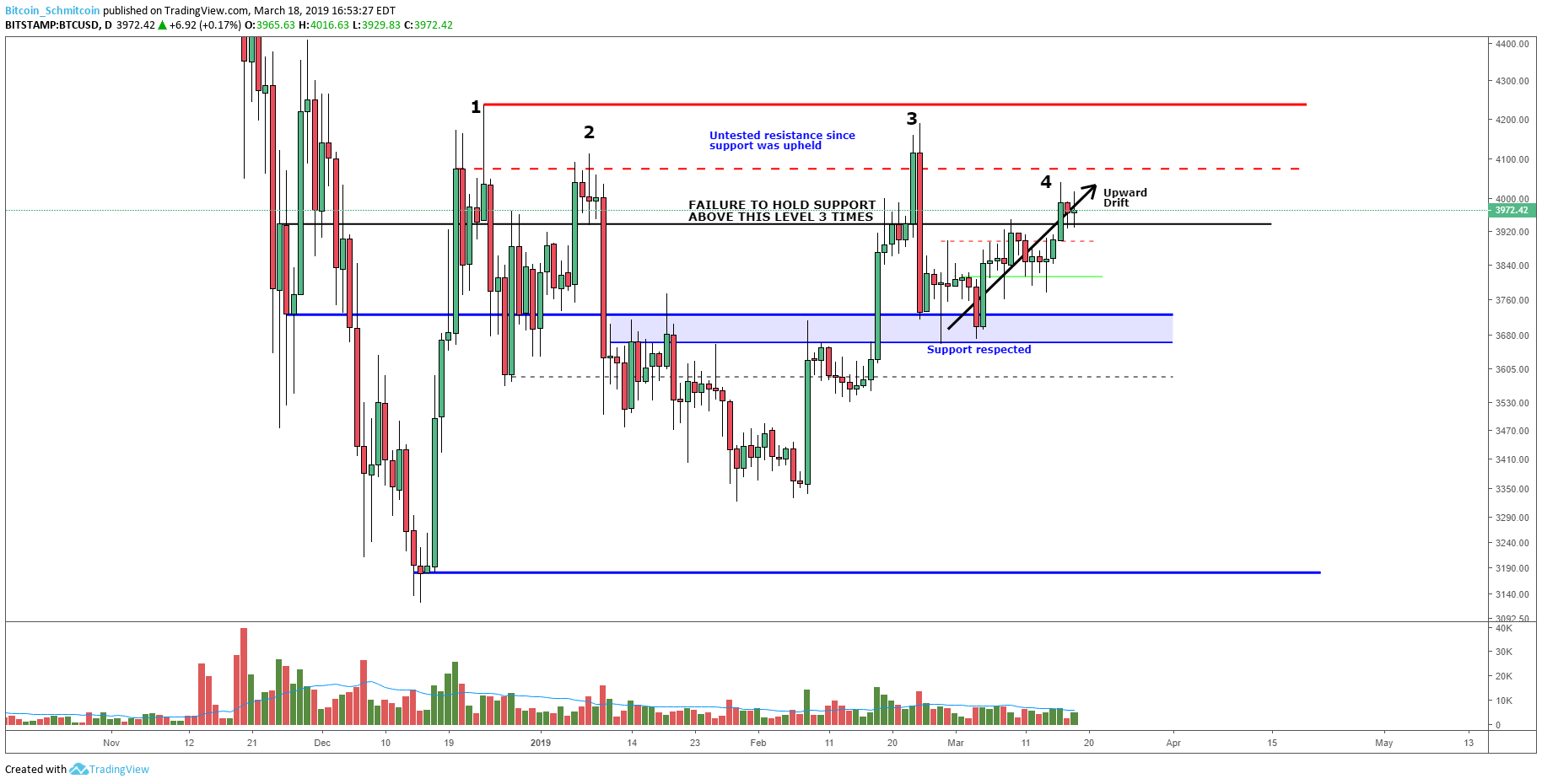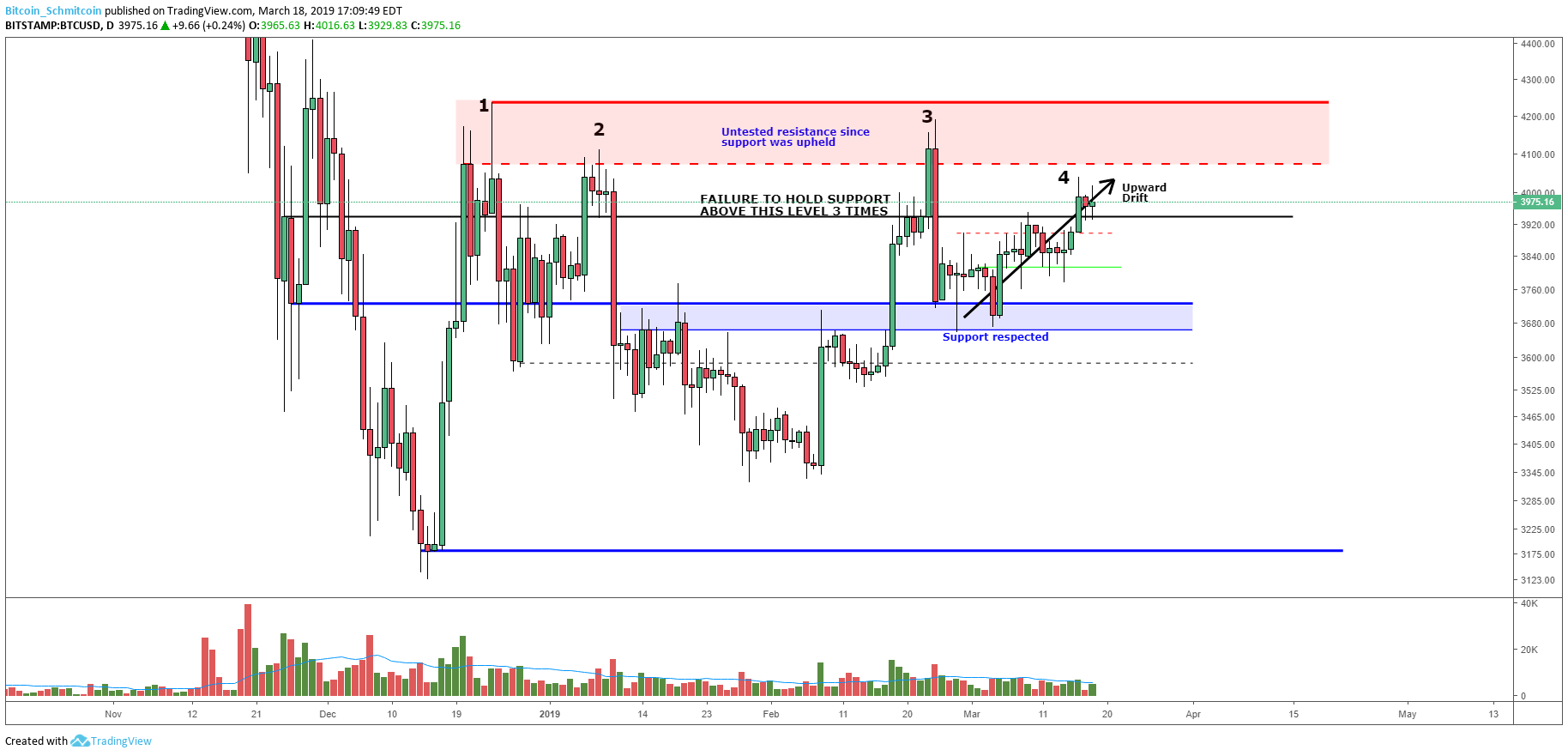
Last Friday, we discussed a macro resistance level bitcoin would likely test. The level was tested three times prior and immediately rejected. Now, for the fourth time, we find ourselves situated above the level as we wait to see if our support holds:
Figure 1: BTC-USD, Daily Candles, Fourth Test of Macro Resistance
The first three attempts to hold support above the black, broken resistance have been stifled with relatively high amounts of volume. However, something to note is that the three rejections of the overhead resistance have become weaker and weaker. Now, on our fourth attempt, we are doing so in a very meandering/drifting manner. Typically, impulsive moves (like the last three attempts) react with impulsive moves in response to the strong move into the level. Grinding moves, however, (like the fourth attempt we are currently experiencing) are often tactics used to trap early shorters and not allow them an opportunity to exit. This sort of position stacking often leads to a “short squeeze.”
A short squeeze occurs when the market stacks a large amount of people trapped in a position without an opportunity to exit. As the market drifts upward, more and more people continue to short the market expecting a pullback. And, in some cases, the market continues to drift upward, causing these short positions to go deeper and deeper into a losing position.
Ultimately, these positions hit a breaking point where they will either be stopped out or force-liquidated, causing a large number of market buy orders to hit the market all at the same time. Right now, we have yet to experience the short squeeze, but we are laying the foundation to create a lot of trapped short positions in a relatively narrow price band:

Figure 2: BTC-USD, Daily Candles, Upward Drift on Fourth Attempt
This upward drift has been persistent as we just ground right through the black resistance shown above. An upward grind like this can often be indicative of bearish exhaustion — especially when we have been strongly rejected several times before. At this level, it seems supply has been exhausted, and we will likely see a retest of the red zone shown below:

Figure 3: BTC-USD, Daily Candles, Macro Resistance Zone
The red zone represents the maximum extent the market has been willing to extend itself prior to being rejected. When the market develops well-defined zones of resistance, it also develops, as a consequence, a tight band of logical stop losses that can be used to fuel either a bullish or bearish rally, depending on the context.
It seems logical that we will revisit this level whether the next major macro move is upward or downward. If we move upward, break new highs and fail to maintain new highs, that can be a bearish signal that large institutions are still unloading their supply and we are ready for a strong reversal.
However, if we visit this zone and continue to grind upward, that could lead to a very powerful breakout of the level. Almost everyone who shorted over the last three to four months would have a logical stop order placed just above the red zone, and it could potentially cascade a short squeeze that would yield a very violent move to the upside.
Summary:
- So far, we are content to stair-step our way through local resistance levels and, for the time being, are finding support on the macro black level shown above.
- If we continue to hold this support level, we can expect to visit the low $4,000 level as this seems like a logical source of liquidity.
- A break of the red zone outlined in this article will likely yield a violent move to the upside as a short squeeze would fuel a bullish rally.
Trading and investing in digital assets like bitcoin is highly speculative and comes with many risks. This analysis is for informational purposes and should not be considered investment advice. Statements and financial information on Bitcoin Magazine and BTC Inc related sites do not necessarily reflect the opinion of BTC Inc and should not be construed as an endorsement or recommendation to buy, sell or hold. Past performance is not necessarily indicative of future results.
